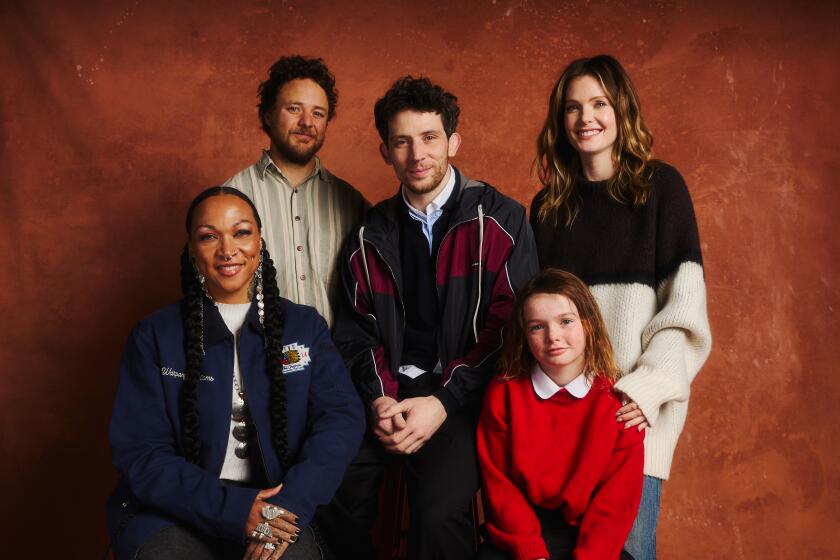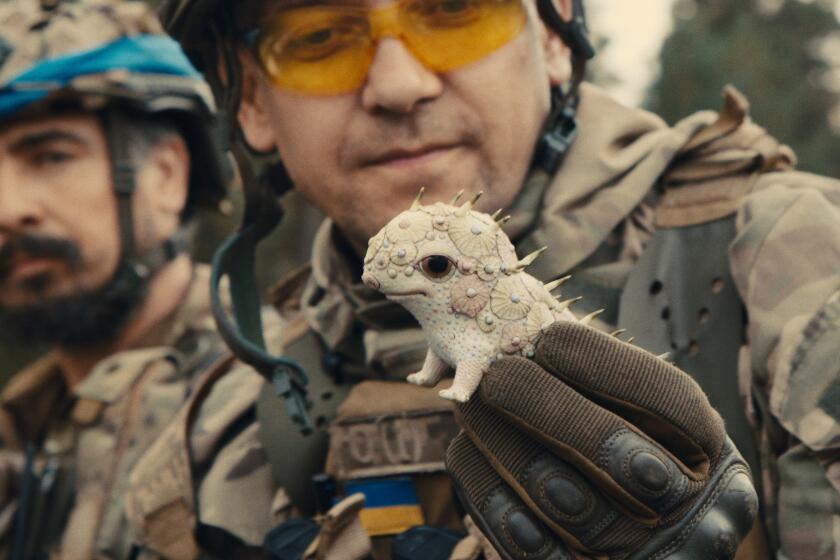Capturing a Fido’s-Eye View for the Big Screen
- Share via
Gary Thieltges needed a dog’s-eye view of the world when shooting a commercial for Miller Brewing Co.’s Red Dog beer last year. In the spot, a low-slung bulldog and his terrier sidekick make their way down a street, with a voice-over by actor Tommy Lee Jones.
The first attempt didn’t capture the right “attitude,” everyone agreed. It needed more pizazz; it was too smooth and staid.
So Thieltges--an experienced director of photography and lifelong tinkerer--rigged a modified Arriflex 35-millimeter camera with store-bought and custom-made accessories, and viola: Doggicam. It was basically a hand-held camera on a stick, with a small viewer to allow the operator to see what the lens is picking up.
“I was able to walk with a swagger down the street with the camera,” Thieltges says. “We could do a quick look in one direction and follow the dogs close to the ground.”
Thieltges saw the potential to market the camera system, named Doggicam by the crew. There’s a finite market for professional camera systems, but there’s always room for a useful new product.
The Steadicam system, for example, invented in the 1970s, has been universally adopted and copied. Other systems, like the Pogocam (nicknamed “the poor man’s Steadicam”) also have been widely accepted.
Doggicam is extremely light at only 17 pounds. That may sound heavy to the layman used to a video camcorder, but film cameras weigh more.
The Steadicam system weighs a hefty 70 pounds. It has to be “worn” and operated by a highly trained professional and can take half an hour or more to reconfigure from “high mode” (for eye-level or higher shots) to “low mode” (for near-the-ground shots). With Doggicam, the time is cut to a few minutes. Doggicam can be used by virtually anyone, Thieltges says. The current 35-millimeter model doesn’t record with sound. But there are many instances when sound recording isn’t needed--audio is added later. Commercials, music videos and action scenes in movies are all examples. Thieltges says he’s also working on a deal for a model that can be used with sound recording.
With a bank loan and money from his savings, Thieltges rented a warehouse-office in Burbank in March.
“I’ve had offers from six people with serious money wanting to invest, but I wanted to maintain control,” Thieltges says.
Doggicam is assembled and rented from the facility. Thieltges has begun to supplement word-of-mouth on Doggicam with postcards mailed to film professionals and ads in a few trade publications. He’s exhibiting at this year’s Show Biz Expo West, running Friday through Sunday at the Los Angeles Convention Center. The expo showcases goods and services for the production community.
Currently, Doggicam is only available for rental; the basic package starts at $950 a day. That’s roughly half the price of a Steadicam rental, when you figure in the cost of a trained Steadicam operator (at approximately $1,000 a day). He’s hoping for $250,000 worth of business his first year.
Thieltges is looking at expanding distribution after he gets established. The rental-only model follows industry giant Panavision’s example. Woodland Hills-based Panavision--whose yearly revenue is about $150 million--operates rental facilities in Woodland Hills and Hollywood.
Big firms like Panavision traditionally have not been particularly aggressive in introducing very lightweight, flexible camera systems like Doggicam, choosing instead to concentrate on multimillion-dollar “core” products. Panavision is introducing a 17-pound 35mm camera at Show Biz Expo, but it’s more expensive and not directly comparable with Doggicam.
The studios and most other entertainment producers rent virtually all of their equipment today, says Denny Clairmont of rental house Clairmont Camera Hollywood.
“Cameras are very expensive to buy. On a big film, the value of the camera equipment can be several million dollars,” Clairmont says. “The studios would rather invest that money in making movies and not have to worry about depreciation, maintenance or theft.”
Doggicam faces an uphill battle in gaining recognition and acceptance.
“There’s nothing worse than getting a piece of equipment on the set that doesn’t work the way you need it to. People are sometimes wary,” Thieltges says.
But Doggicam’s reputation is spreading quickly.
“I’m seeing Doggicam used more and more, particularly for getting low-angle ground shots,” says aspiring director of photography Kelly McGowan, who has worked on numerous commercials, music videos and films.
Commercial director Geoff McGann, of Venice-based HSI Productions, has probably used the Doggicam more than anyone besides Thieltges--the inventor demonstrated it to him about a year ago.
“The lightness of it is really important when you’re working 14-hour days. Gary shaved down the Arriflex so it’s even smaller, which makes it really flexible, too,” McGann says.
McGann, who used Doggicam on a commercial currently running for Little Caesar’s Pizza (where a man tries to get his pizza into the house, past his hungry dog) adds that the other benefits of the system include its durability (“you can really bang it around”) and the fast recharging time of its batteries (15 minutes).
There is one slight drawback to Doggicam, Thieltges says: its catchy name.
“Everyone thinks it’s something you attach to a dog. I keep thinking we’re going to hear from the ASPCA, saying, ‘Just how do you attach this to a dog?’ And I’ll tell them that the hard part is asking the dog to pan right.”
More to Read
Only good movies
Get the Indie Focus newsletter, Mark Olsen's weekly guide to the world of cinema.
You may occasionally receive promotional content from the Los Angeles Times.










